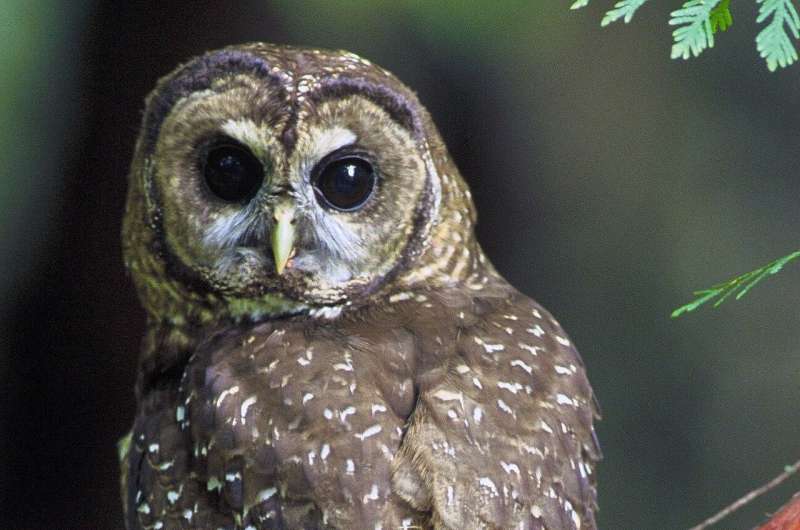This article has been reviewed according to Science X's editorial process and policies. Editors have highlighted the following attributes while ensuring the content's credibility:
fact-checked
reputable news agency
proofread
Kill barred owls so spotted owls can live? Wildlife service should put plan on hold say conservation groups

There is something shocking about trying to save one species by killing nearly half a million of another species. That's what the U.S. Fish and Wildlife Service has proposed in a plan to save the spotted owls of the northwestern United States from extinction by shooting hundreds of thousands of barred owls over three decades.
There's no question the number of spotted owls is dwindling precipitously as barred owls have muscled into their territory in Washington, Oregon, and—to a lesser extent— Northern California over the last 50 years.
This situation has pitted not just owl against owl, but also put animal welfare and conservation groups at odds with each other. In a letter to Secretary of the Interior Deb Haaland sent on behalf of 75 animal welfare and wildlife advocacy groups, Animal Wellness Action President Wayne Pacelle and Scott Edwards, general counsel for the Center for a Humane Economy, called the plan "a colossally reckless action" which would doom the government to perpetual killing to keep the number of barred owls down.
On the other side, Kieran Suckling, the executive director of the Center for Biological Diversity—which has long fought to save the spotted owl—supports the plan. Without it, he says, the northern spotted owl in Oregon and Washington will go extinct and the California spotted owl will become endangered. "Nobody wants to see an owl killed, including ourselves," he said.
Shooting any owl seems like a horrible idea, and the Fish and Wildlife Service should put this fraught plan on hold and look for other options. We know the government biologists didn't come to the plan lightly or quickly. The service has spent years testing its plan by killing a few thousand barred owls in smaller areas to see if spotted owl populations stayed stable. It did. But this is a far bigger plan covering far more territory.
Spotted owls, native to the area, are smaller and breed less often. Picky about where they nest and what they eat, they favor particularly cool and dark cozy cavities of old-growth trees, the supply of which has been dramatically reduced from decades of logging.
Barred owls, on the other hand, are somewhat bigger, more aggressive, and not above taking a spotting owl's locale and food supply. They have been known to kill spotted owls—as well as mate with them, producing what some biologists have nicknamed "sparred owls." The Fish and Wildlife Service calls them hybrids and says they should be shot as well.
Yes, barred owls are technically "invasive." But no one hand-carried them here as pets or imported them for food or entertainment. The barred owls spent the last century expanding their range from the east and Midwest of the U.S. and Canada and now they've been in the Pacific Northwest since the 1970s. They came here because they could.
This current predicament is a result of an ecological horror show—huge amounts of old-growth trees cut down, the increasing frequency and severity of wildfires and the fact that few scientists, if any, realized that barred owls were moving into this area until it was too late to do something less drastic to stop them.
Stuck between letting one species probably die off or killing hundreds of thousands of another species, Fish and Wildlife officials should give some other ideas a look. Instead of shooting birds dead, perhaps consider stopping them from reproducing. The agency says it looked at that and several other methods to control reproduction but they took too long to reduce barred owl populations or were too difficult and expensive to carry out.
It's illegal to hunt either of these birds under the Migratory Bird Treaty Act but the Fish and Wildlife Service can get a permit to allow the killing of animals in order to protect a species listed under the Endangered Species Act.
The northern spotted owl is listed as threatened. The agency would also have to get permission from state authorities. And it's not that they haven't laid out a meticulous protocol for killing. Shooters must be trained and able to distinguish a barred owl from a spotted owl. Birds must be stationary on a perch and "present a full, frontal and unobstructed view" according to the proposal. Any bird wounded but not killed should be euthanized immediately.
The issue is whether they should be killed at all. The plan has never been to eradicate all barred owls—you really can't—but to lessen their numbers enough to give spotted owls some breathing room in the forest. But that could still mean a perpetual killing program as the spotted owl population stabilizes or goes down. (Currently it's decreasing as much as 9% a year in some areas, according to one study.)
Maybe the government should consider what one biologist who has long studied spotted owls has suggested: Let nature take its course and leave it to the owls. That's ecological heresy to many conservationists whose philosophy is that you conserve threatened or endangered species when you have a way to do it. But it's worth taking another look at whether this is a case where conservation of one species warrants killing another.
2024 Los Angeles Times. Distributed by Tribune Content Agency, LLC.



















